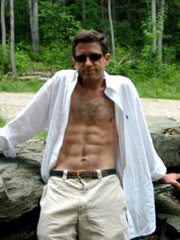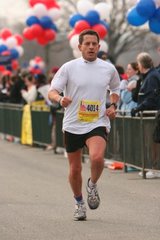Bought the new goat. She's an Alpine, giving us about two quarts of milk every day. Will loves the stuff. John hates it. I saved up enough milk to make a two-pound wheel of goat's milk cheddar over the weekend that's ready for aging. I'll provide a report when it's ready.
Garden worked out OK. The corn was flattened by what was left of Hurricane Ike, but we have more than 100 pints of tomato sauce canned and ready to go. We've got about 50 pints of salsa verde with tomatillos and onions from the CSA. We've got about 50 pints of carrots and about 50 pints of green beans. We've got onions, scallions, blackberries, blueberries, peaches, nectarines, celery, broccoli, bell pepper, herbs and pesto in the freezer. We'll soon have 50 broilers -- they're getting huge -- and three pigs.
I'd say we're ready for winter, but not quite.
The chainsaw blew a piston, and fixing it ran about $200. I took a few days of vacation from the Day Job to finish up this week. The blade was getting a bit dull -- that'll happen when you pinch it in a tall beech tree, like I did -- so I took it to the shop for a quick sharpening. Turns out the replaced piston now needs replacing. Ack. Anyway, at this rate, I'll have our winter wood done by April or so.
We're certainly not ready for the Greater Depression.
But it's not winter just yet, nor has the Greater Depression totally kicked off. And it is gorgeous. The leaves are peaking in southern Vermont this week:

A nice story from this week's WSJ that reminds me I need to get off my ass:
Crash Survivor Scores Rare Triathlon Invite
Wall Street Exec Trains for Legendary Ironman Race
Ten years ago Mr. Morgan wasn't even sure if he'd ever walk again. A plane crash left him with two broken vertebrae in his neck and 30 percent of his body covered in burns. "I had a 50-50 shot at life," Mr. Morgan recalls. "I had to learn everything all over again -- how to brush my teeth, walk, go to the bathroom." Mr. Morgan's entire left arm was burned except for one spot. "I have a complete outline where my Timex Ironman watch was. It is the only spot on my arm where I have hair." The outline reminded Mr. Morgan of Timex's old ad, "It takes a lickin' and keeps on tickin'." He called the company to pitch himself as the subject of its next ad only to discover the campaign had been discontinued. But company representatives said if he ever wanted to do the Ironman he should call back. Mr. Morgan recalls thinking, "I can't even go to the bathroom by myself."
Before the accident Mr. Morgan had competed in sprint triathlons. After physical therapy he returned to the gym five or six days a week to lift weights and ride the Lifecycle bike for 30 minutes. In 2006, Mr. Morgan found himself listening to a client describing how he had competed in the Ironman and it made him remember the Timex offer. He wrote the company to retell his story of the plane crash and his watch "tattoo." In June 2007 he received a surprising call from Herbie Calves, Timex's vice president of sports marketing, asking whether he wanted an Ironman World Championship number for 2007 or 2008. He opted for 2008.
The 38-year-old Mr. Morgan, who co-manages U.S. equity sales trading at J.P. Morgan in New York, has since reprioritized his life to focus on training. He lives in Darien, Conn., and is married with two children. He stands 6-foot-1 and weights 180 pounds.
The Workout
Sponsorships allow many Ironman competitors to train full time. Mr. Morgan doesn't have that luxury. Before he began training for the race, he awoke at 4:30 a.m. to catch the 4:50 a.m. train to midtown Manhattan. Now, he wakes up at 3:20 a.m. three days a week to ride, run or swim for an hour before work. In January, Mr. Morgan hired a personal trainer who creates workouts he can download to his Blackberry. He can call her any time he has questions or needs motivation. "The other day I wasn't feeling the 22-mile run and she tells me, 'Think 22 miles plus 100% humidity on black lava.' I pay for that," he says. In addition to his morning workouts, he sometimes tacks on an additional run or bike ride after work, depending on what his trainer recommends.
On weekends, Mr. Morgan swims at his local YMCA and bikes 100 to 120 miles, followed by a 30- to 40-minute run. In bad weather, he puts his bike on a trainer so he can cycle inside while watching episodes of the HBO comedy "Entourage." According to the Ironman media guide, the average competitor trains between 18 and 30-plus hours per week: about seven miles per week swimming, 225 miles per week biking and 48 miles per week running. Mr. Morgan says his typical week sees him swim five miles, bike 150 to 170 miles and run 30 miles. To prepare himself for race day, he competed in two half-Ironmans, one in May and one in June.
Sample Workout
Mon. – Rest day
Tues.-Thurs. – 60-minute run, bike or swim
Sat. – Bike 120 miles followed immediately by a three-mile run.
Sun. – 20-mile run; swim.
Mr. Morgan hit a hurdle last October when he developed plantar fasciitis, a painful inflammation in the foot most often felt in the heel. "I can't get rid of it," he says. "You really have to walk away from [training] for it to heal, but I can't afford to." He goes to a doctor in the city once a week for laser treatment to break down the scar tissue and has also ordered custom orthotics for his sneakers. He stretches daily to ease the pain.
The Diet
Eating more and more often is Mr. Morgan's new dietetic challenge. "I could go home and eat a pint of Ben & Jerry's every night and still lose weight," he says. Mr. Morgan estimates that he has lost 15 pounds since he started training. To maintain his energy, he tries to eat every three hours. In the morning he has Raisin Bran topped with a banana and skim milk, followed by a cup of coffee and an energy bar. After his workout he has a recovery drink. He eats lunch at his desk, usually a turkey sandwich on whole wheat, which he orders in. "I probably eat chicken, vegetables and pasta seven nights a week, 365 days a year," he says.
Many athletes drastically change their diet during training. "I don't have free time to weigh everything and I'm not a bad eater," says Mr. Morgan, who instead paid Trismarter.com, a company that specializes in designing nutrition and exercise programs for triathletes, to create a diet plan specifically focused on the two days leading up to the race and the race day. He says it recommends hydrating every 10 minutes during the cycling portion. Mr. Morgan set his watch to beep every time he needs to rehydrate or refuel, ingesting calories from Gu, an energy gel, and Fig Newtons. During the run he ingests Gu every hour and drinks water or Gatorade at every mile marker.
The Cost
Tens of thousands of athletes try to get one of the coveted 1,800 spots through a lottery or by winning a spot at one of the qualifying events held around the world. "Spots are sold on eBay for up to $60,000," Mr. Morgan says. Timex covered the majority of Mr. Morgan's costs, including the $300 entry fee, and provided him with his jersey, hats, and a Timex team Trek bike.
Since January, Mr. Morgan has bought four pairs of running sneakers, costing between $80 and $110 per pair. After his wife pleaded with him, he also bought a new pair of cycling shoes, which he wears without socks. Triathlons are a gear geek's dream sport. "It's like a different version of golf," he says. "I could come home every day and go on one of 30 sites and buy a new water bottle holder or Gu or visor." Timex supplied Mr. Morgan with his bike, which could run from $3,000 to $20,000. He spends $250 a month on his personal trainer and paid $300 for his Trismarter.com nutrition evaluation. Membership at the YMCA is about $100 a month.
The Effort
Mr. Morgan says his biggest issue is time management. Making time for family and staying on top of his game at work have been a challenge. "I'm struggling to prioritize it all," he says. "My wife is so done with this." He works out at 4:30 a.m. on weekends to get in his training before his family wakes up. Mr. Morgan started at J.P. Morgan in June. "Any time you start in a new environment you have to prove yourself again," he says. "If I had been there six years it might be easier to take more luxury, but I pride myself on my work ethic and am one of the first people there in the morning."
The Benefit
Mr. Morgan's family and friends will join him in Hawaii to cheer him on. They are staying four days after the race to enjoy Hawaii. "I may not move the first two days," he jokes. Mr. Morgan says one of the professional triathletes gave him his best advice yet: "He told me the biggest waste is running down hard that last mile to the finish line. He wasn't telling me to walk but just to slow down and absorb it because I'm proving the impossible possible."
Write to Jen Murphy at workout@wsj.com
![[A.C. Morgan]](http://s.wsj.net/public/resources/images/OB-CL722_morgan_D_20081006152226.jpg) A.C. Morgan
A.C. Morgan











No comments:
Post a Comment